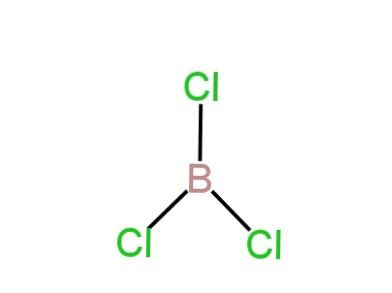
Which one of the following is a planar molecule
A. \[NH_3\]
B. \[H_3O^{+}\]
C. \[BCl_3\]
D. \[PCl_3\]
Answer
221.1k+ views
Hint: Trigonal planar structure is depicted by a molecule having one central atom bound to the other three atoms resembling the corner of an equilateral triangle. The bond angles are \[120^o\].
Complete step by step solution:Here in this question, we have to find out which of the following molecules has a planar structure.
A. \[NH_3\]
Here N is the central atom. Nitrogen has five electrons in its valence shell.
Three electrons are involved in bond-making and two other electrons pair up.
So, it has three bond pairs and one lone pair.
So, it has a trigonal pyramidal structure.
So, A is incorrect.
B. \[H_3O^{+}\]
Here O is the central atom. It has a positive charge and thus has five electrons in this valence shell.
Three electrons bond with three electrons each from a hydrogen atom. One lone pair is present.
So, there are three bond pairs and one lone pair.
So, it has a trigonal pyramidal structure.
So, B is incorrect.
C. \[BCl_3\]
Here Boron is the central atom.
It includes three electrons in its valence shell.
Three electrons are involved in bond-making.
So, it has three bond pairs.
So, it has a trigonal planar structure.

Image: Structure of BCl3
So, C is correct.
D. \[PCl_3\]
Here P is the central atom. It includes five electrons in its valence shell.
Three electrons are involved in bond-making and two other electrons pair up.
So, it has three bond pairs and one lone pair.
So, it has a trigonal pyramidal structure.
So, D is incorrect.
So, option C is correct.
Note: In chemistry, hydronium is the common name for the aqueous cation H3O+.
It is usually considered as the positive ion present when an Arrhenius acid undergoes dissolution in water.
Arrhenius acid molecules in solution lose proton \[H^+\] to the surrounding water molecules forming hydronium ions.
Complete step by step solution:Here in this question, we have to find out which of the following molecules has a planar structure.
A. \[NH_3\]
Here N is the central atom. Nitrogen has five electrons in its valence shell.
Three electrons are involved in bond-making and two other electrons pair up.
So, it has three bond pairs and one lone pair.
So, it has a trigonal pyramidal structure.
So, A is incorrect.
B. \[H_3O^{+}\]
Here O is the central atom. It has a positive charge and thus has five electrons in this valence shell.
Three electrons bond with three electrons each from a hydrogen atom. One lone pair is present.
So, there are three bond pairs and one lone pair.
So, it has a trigonal pyramidal structure.
So, B is incorrect.
C. \[BCl_3\]
Here Boron is the central atom.
It includes three electrons in its valence shell.
Three electrons are involved in bond-making.
So, it has three bond pairs.
So, it has a trigonal planar structure.

Image: Structure of BCl3
So, C is correct.
D. \[PCl_3\]
Here P is the central atom. It includes five electrons in its valence shell.
Three electrons are involved in bond-making and two other electrons pair up.
So, it has three bond pairs and one lone pair.
So, it has a trigonal pyramidal structure.
So, D is incorrect.
So, option C is correct.
Note: In chemistry, hydronium is the common name for the aqueous cation H3O+.
It is usually considered as the positive ion present when an Arrhenius acid undergoes dissolution in water.
Arrhenius acid molecules in solution lose proton \[H^+\] to the surrounding water molecules forming hydronium ions.
Recently Updated Pages
The hybridization and shape of NH2 ion are a sp2 and class 11 chemistry JEE_Main

What is the pH of 001 M solution of HCl a 1 b 10 c class 11 chemistry JEE_Main

Aromatization of nhexane gives A Benzene B Toluene class 11 chemistry JEE_Main

Show how you will synthesise i 1Phenylethanol from class 11 chemistry JEE_Main

The enolic form of acetone contains a 10sigma bonds class 11 chemistry JEE_Main

Which of the following Compounds does not exhibit tautomerism class 11 chemistry JEE_Main

Trending doubts
JEE Main 2026: Application Form Open, Exam Dates, Syllabus, Eligibility & Question Papers

Derivation of Equation of Trajectory Explained for Students

Hybridisation in Chemistry – Concept, Types & Applications

Understanding the Angle of Deviation in a Prism

How to Convert a Galvanometer into an Ammeter or Voltmeter

Degree of Dissociation: Meaning, Formula, Calculation & Uses

Other Pages
NCERT Solutions For Class 11 Chemistry Chapter 7 Redox Reaction

JEE Advanced Marks vs Ranks 2025: Understanding Category-wise Qualifying Marks and Previous Year Cut-offs

Hydrocarbons Class 11 Chemistry Chapter 9 CBSE Notes - 2025-26

Thermodynamics Class 11 Chemistry Chapter 5 CBSE Notes - 2025-26

NCERT Solutions ForClass 11 Chemistry Chapter Chapter 5 Thermodynamics

Equilibrium Class 11 Chemistry Chapter 6 CBSE Notes - 2025-26




